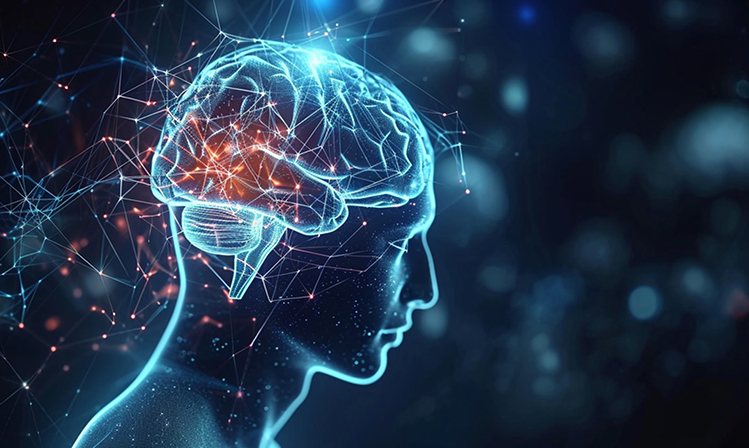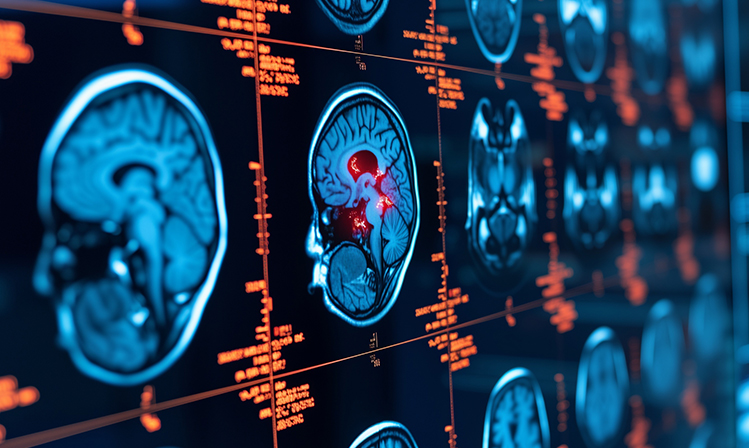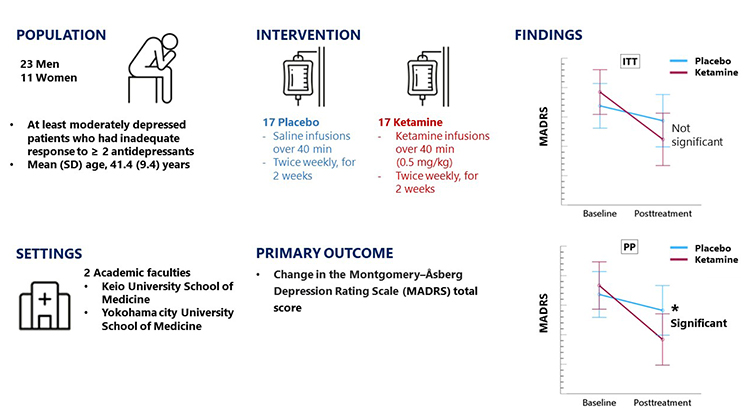Research outcomes of the Program for the Advancement of Next Generation Research Projects
School of Medicine
Hiroyuki Uchida
Ketamine is a promising drug for depression because of its antidepressant effect when used as a subanesthetic dose. However, the mechanism of this effect is still not understood. Now, a PET study using a novel ligand for AMPA receptors successfully identified brain regions that were linked to the antidepressant effect of ketamine.

Depression is a common mental illness signified by depressed mood, melancholy, and lack of motivation, as well as physical symptoms such as insomnia, fatigue, and loss of appetite. The lifetime probability of being afflicted by depression is as high as 6.5% and this rate is increasing. By some studies, depression is reported to become the leading disability by 2030 in terms of disability-adjusted life years. However, approximately one-third of patients do not respond to the conventional pharmacological and non-pharmacological treatments, referred to as treatment-resistant depression (TRD).
Recently, ketamine is the focus of attention as a next-generation drug for depression. Although ketamine has been used as an anesthetic, a strong antidepressant effect of a single subanesthetic dose of ketamine was reported in 2000. Since then, its strong and rapid antidepressant effects have been reported numerous times in clinical trials in the United States and Europe. Esketamine nasal spray obtained the indication for treatment-resistant depression in the United States. Further clinical trials of ketamine for use in the treatment of depression are ongoing worldwide.
On the other hand, it is still unclear how ketamine exerts its antidepressant effect. Some preclinical studies on mice have suggested that ketamine has antidepressant-like effects by increasing the amount of AMPA (α-amino-3-hydroxy-5-methyl-4-isoxazole propionic acid) receptors in the prefrontal cortex. AMPA-type glutamate receptors mediate excitatory synaptic functions and are the central mediator of neuronal functions such as memory and learning. However, AMPA receptor distribution in humans has not been investigated because no techniques to visualize AMPA receptors in the living human brain were available.
In 2020, Prof. Takuya Takahashi, Department of Physiology, Yokohama City University School of Medicine, and his colleagues, successfully developed a novel positron emission tomography (PET) tracer, namely [11C] K-2, that specifically binds to AMPA receptors in the human brain. In collaboration with Prof. Hiroyuki Uchida at the Department of Neuropsychiatry, in the Keio University School of Medicine, and his colleagues, they measured the amount and distribution of AMPA receptors in patients reporting depression using AMPA-PET imaging. They found that the amount of AMPA receptors was decreased in specific brain regions and that this decrease was correlated with the severity of depression (in submission). As a next step, Prof. Uchida and his colleagues administered ketamine to patients with TRD. They measured AMPA receptor distribution changes with ketamine treatment, thereby revealing the dynamics of the neural circuitry in the recovery process of depression in the current study.
The researchers included 34 Japanese patients with TRD who were at least moderately ill and whose current episodes of depression had not improved adequately with the use of two or more antidepressants. Ketamine (0.5mg/kg) or saline was administered intravenously twice a week for two weeks in a double-blind randomized fashion. AMPA-PET scans were performed before and after treatment. The clinical severity of depression was assessed using the Montgomery-Åsberg Depression Rating Scale (MADRS).

Figure 1:
Efficacy of intravenous ketamine in Japanese patients with treatment-resistant depression: a double-blind, randomized, placebo-controlled trial
© Keio University
There was no significant difference in the MADRS total score changes between the ketamine group (N = 17) and the placebo group (N = 17) in the intention-to-treat analysis (i.e., analyzed all the participants who enrolled on the study, including those who discontinued the study); however, a significant reduction in the MADRS total score was observed in the ketamine group (N = 15) compared to the placebo group (N = 16) in the per-protocol analysis (i.e., focused on participants who completed the study and excluded those who dropped out of the study treatment). These results suggested that ketamine treatment would be effective in Japanese patients with TRD, as in North America and European countries.

Moreover, the current study found that the amount of AMPA receptors increased in specific brain regions after ketamine treatment. This increase was correlated with an improvement in depressive symptoms. These results suggested that AMPA receptor density increases in the brain may play critical roles in the mechanism of the antidepressant effect of ketamine in patients with TRD.
To quote Prof. Uchida and colleagues: "We now successfully identified brain regions in the recovery of depression associated with ketamine treatment from the perspective of neural plasticity. In the future, investigating the relationship between the current findings and other neuroimaging modalities will lead to a more comprehensive understanding of the recovery process. It will be a cornerstone in the development of new treatments for depression."
Reference
- Berman, M., Cappiello, A., Anand, A., Oren, A., Heninger, R., Charney, S., Krystal, H. Antidepressant effects of ketamine in depressed patients. Biol Psychiatry. 47:351-4 (2000).
- Miyazaki, T., Nakajima, W., Hatano, M., Shibata, Y., Kuroki, Y., Arisawa, T., Serizawa, A., Sano, A., Kogami, S., Yamanoue, T., Kimura, K., Hirata, Y., Takada, Y., Ishiwata, Y., Sonoda, M., Tokunaga, M., Seki, C., Nagai, Y., Minamimoto, T., Kawamura, K., Zhang, R., Ikegaya, N., Iwasaki, M., Kunii, N., Kimura, Y., Yamashita, F., Taguri, M., Tani, H., Nagai, N., Koizumi, T., Nakajima, S., Mimura, M., Yuzaki, M., Kato, H., Higuchi, M., Uchida, H., Takahashi, T. Visualization of AMPA receptors in living human brain with positron emission tomography. Nat Med. 26:281-288 (2020).
Keio University Program for the Advancement of Next Generation Research Projects
The Keio University Program for the Advancement of Next Generation Research Projects subsidizes research costs with the aim of finding solutions to challenges and of promoting global academic research in order to allow Keio University faculty members to establish a presence as core researchers.